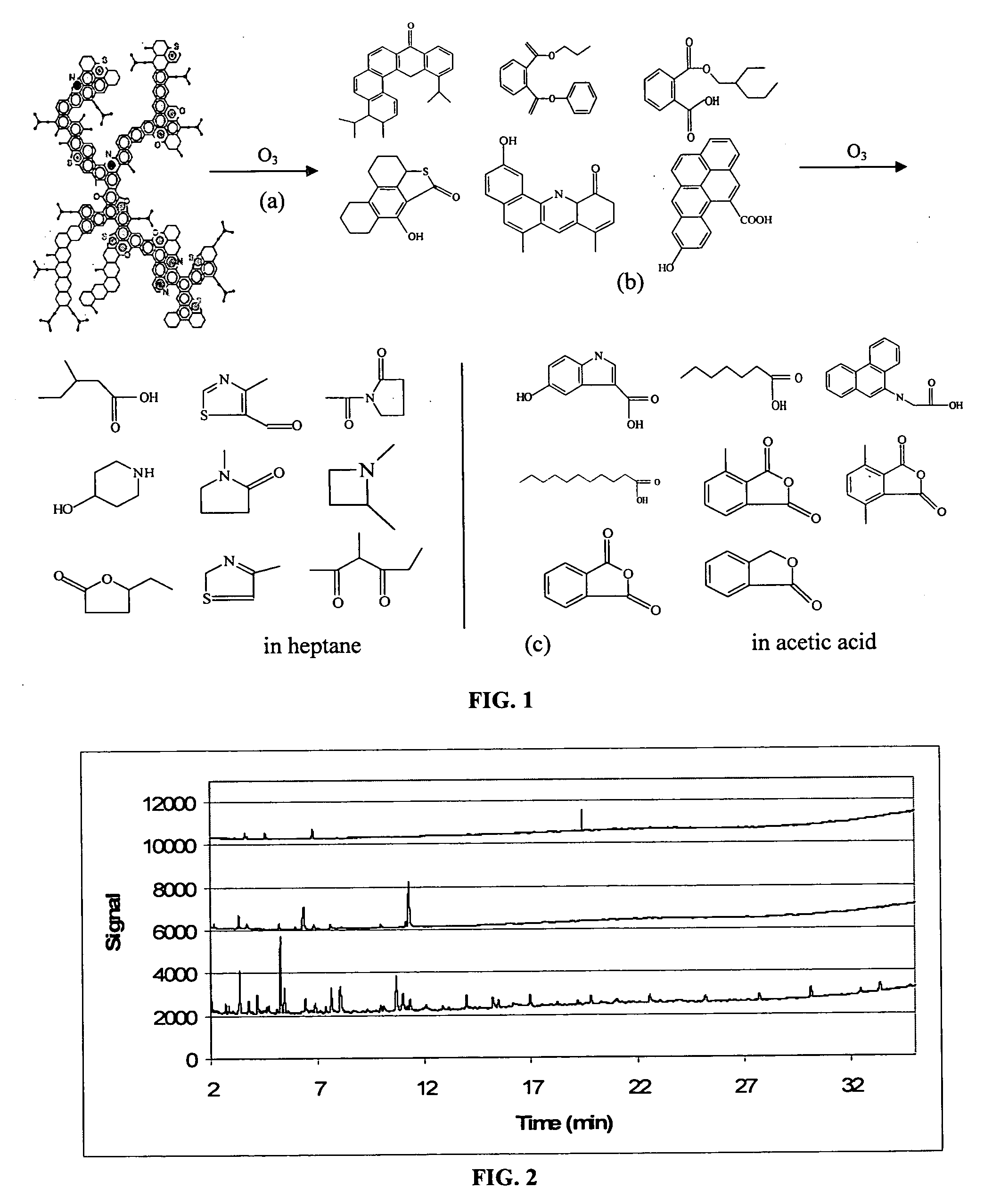Fragmentation of heavy hydrocarbons using an ozone-containing fragmentation fluid
a technology of heavy hydrocarbons and fragmentation fluids, applied in the direction of working up tar by chemical refining, thermal non-catalytic cracking, etc., can solve the problems of reducing the economic use of heavy hydrocarbons, remaining virtually undeveloped, and unable to meet the requirements of economic developmen
- Summary
- Abstract
- Description
- Claims
- Application Information
AI Technical Summary
Benefits of technology
Problems solved by technology
Method used
Image
Examples
example 1
[0049] An asphaltene-containing petroleum waste product containing up to about 40% asphaltene by weight was mixed with heptane to form a slurry. The heptane slurry was stirred and ozonated for 10-60 min. After the tar sand was separated by filtration and the filtrate evaporated, a light-color oil was produced (products identified in FIG. 1C).
[0050] Similarly, an amount of 5 grams of asphaltene petroleum waste was placed in 100 mL of heptane to form a slurry. Under continuous mixing conditions, ozone (about 1-2% ozone by weight) was passed through the slurry at a rate of about 0.8 L / min. A light oil was recovered at a weight of about 0.31 g. The yields and ozonation duration have not been optimized; however, the above results indicate recovery of useful light oils can be achieved using this process.
[0051] Additional control experiments without either ozone or tar sand yielded no light oil, but a small amount of dark residue (0.1 g) extracted from the solid. The combined mass of the...
example 2
[0052] The same asphaltene-containing waste as above was ozonated as described in Example 1 using acetic acid as a treatment medium. The described procedures yielded a variety of additional compounds (products also identified in FIG. 1C) with comparable weight changes after ozonation, and again no significant changes after aeration.
example 3
[0053] Asphaltene-containing waste (as in Example 1) in an amount of 3 grams was soxhlet-extracted with 250 mL of dichloromethane (DCM), resulting in a dark crude oil-like solution. GC / FID results of the dark solution showed primarily an unresolved complex mixture (UCM) prior to ozonation as shown in FIG. 2 (upper line). The UCM was subjected to ozonation for about 10 min and GC / FID analysis revealed an abundance of new compounds with small retention times (<30 min) as shown in FIG. 2 (lower line). The center line of FIG. 2 shows the DCM solvent without the asphaltenes after ozonation for 10 minutes as a comparison. The results show that the heavy asphaltenes were fragmented into smaller compounds.
PUM
| Property | Measurement | Unit |
|---|---|---|
| Tc | aaaaa | aaaaa |
| pressure | aaaaa | aaaaa |
| weight | aaaaa | aaaaa |
Abstract
Description
Claims
Application Information
 Login to View More
Login to View More - R&D
- Intellectual Property
- Life Sciences
- Materials
- Tech Scout
- Unparalleled Data Quality
- Higher Quality Content
- 60% Fewer Hallucinations
Browse by: Latest US Patents, China's latest patents, Technical Efficacy Thesaurus, Application Domain, Technology Topic, Popular Technical Reports.
© 2025 PatSnap. All rights reserved.Legal|Privacy policy|Modern Slavery Act Transparency Statement|Sitemap|About US| Contact US: help@patsnap.com

